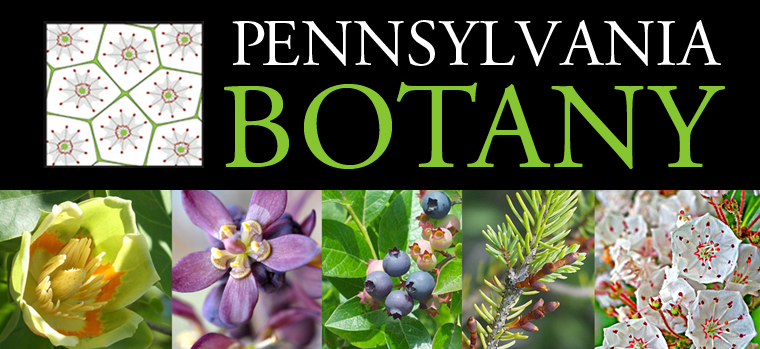
SYMPOSIUM WORKSHOP ABSTRACTS
Select the names of our instructors, below, to jump to their bios.
The contents of this page are available for printing from this PDF.
Dichanthelium. Claire Ciafre, Instructor. Panicking about the panic grasses? Or are you bewitched by the witchgrasses? Either way, this workshop is for you. Participants will learn about the ~35 species of Dichanthelium known from Pennsylvania, including their unique reproductive strategy and where each might be found. Participants will also learn the diagnostic characters necessary for identifying these grasses to species with various dichotomous keys, and will practice keying pressed specimens. A field trip is also planned for the afternoon to observe plants in situ. Dissecting scopes and various dichotomous keys will be provided, but feel free to bring a hand lens and your favorite key if you have one! Participants may also bring specimens of their own to practice on and confirm.
Winter Trees and Shrubs. Norris Muth, Instructor. If identifying plants sometimes feels a bit like magic to your friends (or to you), then identifying woody plants in winter is pure wizardry. Odds are you know more about what to look for in winter woody ID than you think. The goal of this workshop will be to build on what we know about plant identification (although we are happy to work with all skill levels – no prior knowledge or experience necessary) and to become close observers of trees and shrubs in their winter forms. Learning how to identify wood plants in winter is a skill that not only can extend your survey-season, it also improves your growing-season ID skills, and generally makes you a better and happier person. And it makes you a wizard. While we’re at it, let’s give this workshop, and your future wizard-like abilities, a cool mystical name, Hibernal Dendrology.
Introduction and Identification of Bryophytes Common to Pennsylvania. Scott Schuette, Instructor. There are 560 bryophytes taxa in 244 genera across 85 families, which comprises about 14% of the Pennsylvania Flora. They are found in all types of habitats ranging from the pristine to the highly anthropogenic. This workshop is designed to introduce people to the diversity of bryophytes in Pennsylvania through classroom and in the field observations. We will explore the bryophyte lexicon to acquaint participants with the key morphological characters that are used to define families and genera. Using this information as a foundation, we will dive into the defining microscopic features for commonly encountered species. Participants must be comfortable working with microscopes and dissection tools such as razor blades and forceps. A field excursion is planned to demonstrate species in their habitats and proper collecting technique. The collected specimens will be brought back to the classroom for identification and learn the procedure for processing it into an herbarium specimen.
Wetland Plant Identification. Jeff Polonoli, Instructor. With over three thousand plant species growing within Pennsylvania, it’s not surprising most novice wetland delineators struggle with ‘taxonomic illiteracy’. Proficiency in plant identification involves detailed observations, recognizing patterns, and organizing information. Organizing information when observing an unknown plant is where most fall short.
This half day workshop introduces an approach to plant identification where emphasis is placed on learning to distinguish the major plant families prior to memorizing random plant species. The workshop begins with an overview of the content and technical skills necessary to identify plants. Next, participants explore the diagnostic characteristics of plant families while examining pressed specimens of common Pennsylvania wetland plants. Participants will then apply this family first approach to plant identification by sorting and identifying specimens of Pennsylvania’s rare and threatened wetland plants and their look alike species. Useful wetland plant identification resources such as technical keys, websites, and phone apps will be highlighted.
The workshop will be taught at the novice level and focus on wetland species, yet anyone interested in improving their plant identification skills while learning to identify some of Pennsylvania’s common and protected wetland plant species are welcome.
Identifying Invasives Amongst Their Look-Alikes and the Implications for Management. Brian Daggs, Instructor. Invasive species remain one of the greatest challenges that conservationists and environmental professionals face today. Non-native plants encroaching on the habitats that we hope to conserve threaten to overcrowd and outcompete native flora, alter the natural disturbance regimes, interrupt critical interactions between plants and wildlife, and hybridize with closely-related native species. Proper management of invasive plants begins with accurate identification of the species that pose a significant risk to native ecosystems.
Brian Daggs has spent the last few years navigating the task of proper invasive plant identification to inform appropriate management decisions. Making the correct species identification can be the difference between quickly eliminating a pioneer population of an aggressive weed or the accidental eradication of a rare native species. In this workshop, Brian will discuss how to identify several invasive plants compared to their closest look-alikes, and how their presence may impact management decisions.
Introduction to Plant Fossils and Paleobotany. Peter Wilf, Instructor. Plants provide us with oxygen, food, clothing, and medicine and structure the ecosystems that we live in. Understanding the origins and evolution of our green planet is not only a scientific pursuit—it is fundamental to interpreting our existence. Dr. Peter Wilf and students from the Penn State Paleobotany Lab will introduce participants to paleobotany, fossil plant preservation, and iconic types of plant fossils found in Pennsylvania and around the world. They will then present vignettes from their research that show some of the many ways plant fossils are used to understand the evolution of land plants, landscapes, ecosystems, and biomes of the Earth. The workshop will conclude with a guided lab session wherein participants will examine a representative set of plant fossils from the Penn State teaching collections.